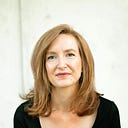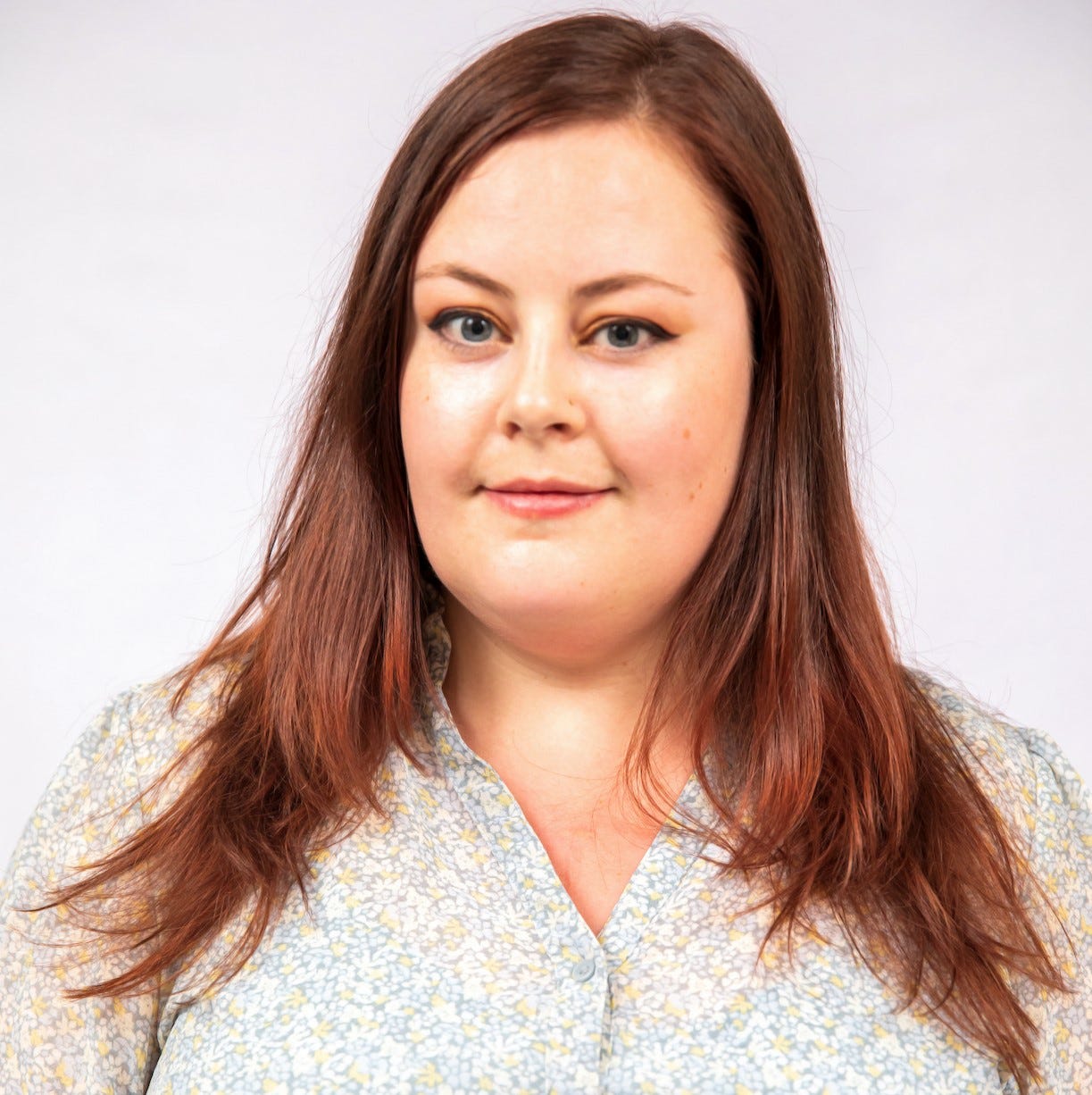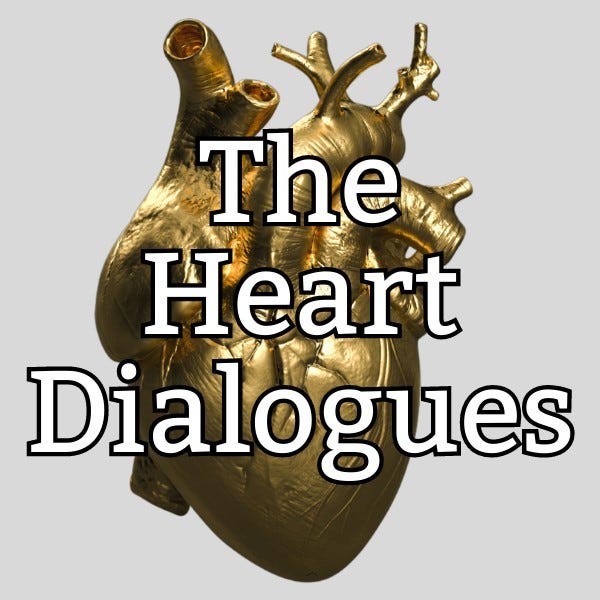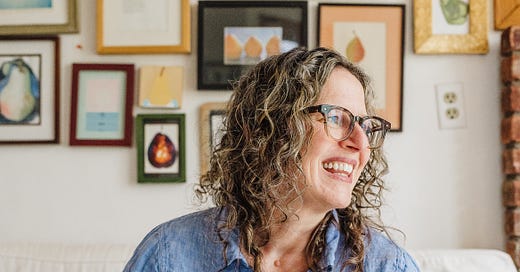

Discover more from Write More, Be Less Careful
how journalist and The Heart Dialogues creator Leigh Kamping-Carder rebuilt her creative practice
four key practices for reconnecting with your creative spark, plus a writing exercise grounded in observation and the body
Today I’m excited to share another entry in the new tending section, which is a mix of essays and interviews about creative practice that do a deeper dive into a particular craft element or process question.
Today’s newsletter features writer Leigh Kamping-Carder, who writes the beautiful newsletter The Heart Dialogues, which focuses on writing and community for people with congenital heart disease (and the people who care about them). These two recent pieces—The freedom of not wanting kids and Don't call me a warrior provide a little preview of the scope of Leigh’s newsletter, as well as her ability to really seamlessly blend memoir, reporting, and research. You may have seen her recent interview at Burnt Toast, in an interview with , "It Felt Like I Could Never Be Healthy Enough."
I’d love your suggestions of other writers and artists to feature in this series, so feel free to email me with ideas. You can just hit “reply” to this newsletter.
I got to know Leigh when she wrote to me to tell me about her own recent return, after a successful career in journalism, to doing creative work, or writing for herself. Her journey is one that I think so many of us can connect with—I know it reflects the struggles I had when I was a high school English teacher. I was constantly enmeshed in my students’ writing and the books we were reading together, and it was so hard to carve out brain space for my own creative work. Leigh wrote to me that “I somehow stopped writing for myself or in any kind of creative way about six or seven years ago. My professional life surrounded me with words, and yet my creative life (and self) had dried up. Then, in the past year, I managed to find my way back to it.”
And that was the part I wanted to learn about—how do you find your way back to the creative part of your brain and heart? And can you do that without upending the career you’ve built? (Spoiler: Leigh’s still a successful journalist—but now she’s doing her own creative work, too!)
Below, Leigh offers four key steps for reconnecting with your writer self and shares a great exercise aimed at removing roadblocks and grounding your writing practice in the body.
Leigh, on ways to reconnect with your writing self
Becoming a journalist was the best and worst thing for my writing life.
My writer self emerged at 10 years old, when I scrawled my first short story in a floppy school notebook, my looping pencil spelling out the title: “The Dragon’s Battle.” Later, I attended sleepaway camps for creative writing and got thick volumes of poetry as birthday gifts. When adults asked me what I wanted to be when I grew up, I wouldn’t hesitate: “A writer.”
I studied cultural journalism in grad school and got a job in 2009 as a reporter covering legal news and litigation. (The state of the industry was such that I was grateful for any kind of full-time work.) Over the years, I moved on to covering real estate, then emerging technology. In 2015, I got a job at a major U.S. newspaper, where I did many of the things my younger self had hoped for me: travel to new places, pry into people’s lives, put it all on a page and see my name as a byline. I also got used to writing in an institutional voice. I crafted every sentence for concision and accuracy, not beauty or emotion. My sporadic attempts at freelance pieces dwindled to nothing. It was never me on a page. I was writing, sure, but I wasn’t writing.
In the fall of 2022, that began to change. I started writing creatively again, launched a Substack called The Heart Dialogues, and even published first-person essays at the paper where I work. What follows are the elements that were essential to rebuilding my writing practice. I hope that some of this might help others seeking to reconnect with their writer selves.
Join a community
In September 2022, I started attending a weekly virtual class for artists who wanted to overcome creative blocks. After that, I took an in-person personal essay writing workshop. We continue to meet to this day (hi guys!).
Not everyone has the time or money to commit to a class. But finding likeminded people—even subscribing to this newsletter or checking in with a writer friend once a month—is crucial. Accountability is great, of course, but even more meaningful is meeting others who reinforce the idea that this work matters. I needed to commune with people who know that being a writer is important.
Build a habit
The repetitions, not the results, are the goal. This is one of the best pieces of advice the creativity coach taught me. (Yes, a creativity coach might sound a little “woo woo,” but she is a brilliant artist, and she got me out of my rut.) On her instructions, I blocked out 20 minutes of studio time on my calendar each Sunday morning. I bought a green spiral notebook and a blue pen that glided across the paper. And I wrote. Nonsense, mostly. But the point wasn’t to produce something; it was to build a habit. You can build a habit in 20 minutes a week, and once you build it, the rest follows.
Don’t plan; just start
I had planned to start a Substack for well over a year at this point. Every couple of months, I would “work” on it—i.e. design elaborate plans about what sections I would have, who my audience would be, how I would grow. I even thought about events and merch. Merch! Did I write a word? No. I kept comparing my vision to long-established newsletters and memoirs and podcasts, wondering how to turn my acorn of an idea into one of those oak trees.
I had to reverse my way of thinking. I had to release myself from all expectations and just start. When I launched The Heart Dialogues, I set up an “About” page, I shared the signup link, and I published a Q&A, a familiar format for me. The goal was not to create my vision but to stick to a regular publishing schedule—to do it, and then do it again, and then do it again. Don’t let your ambition hold you back from doing the work.
Find the process that works for you
These days, I write at a sit-stand desk in my living room, on a laptop, in a Google document—the exact same setup as the work I do for my job. Some writers swear by writing by hand or want a dedicated area. I’m too impatient for the former and too squeezed for space in my New York apartment for the latter. I also have the Google doc app on my phone in case inspiration strikes.
My first drafts are sprawling. (This one started at 2,349 words.) I pour everything into a Google doc, deleting nothing. Then, I start a new doc and take a first pass at editing, looking more at the structure, putting things in order. I often use capitalized headings to delineate sections of an essay or reported piece. Then another Google doc—again, deleting nothing, in case I want to restore something later—where I start refining at the sentence level. I’ve used the same process when writing for work.
Getting down everything I want to say at least once helps me detach from it, making it easier to be ruthless about cuts. My editor’s brain—so handy on the job—takes over. (Though it can often be hard to quiet that part of my brain and actually share the work later!) My goal, whether writing creatively or professionally, is the most taut and impactful prose possible.
If you’d like to try it out...
This exercise is designed to remove the roadblocks from starting a piece of writing, get you back in your body, and generate a handful of beginnings.
Go for a walk. Thirty minutes is great, but five minutes works too. You don’t have to move quickly or even leave the house.
Set a 60-second timer on your phone. When the alarm goes off, take a photograph. Don’t compose a scene; press the button and move on. Repeat.
Later, write a single sentence based on each photo—the first line of a poem, a description of the image, whatever. Don’t edit or second guess yourself.
Do any of the lines speak to you? Use them as jumping off points for your writing.
Leigh Kamping-Carder is the writer of The Heart Dialogues, a free newsletter and community for the millions of people worldwide who were born with a heart condition (and the people who care about them). She is an award-winning journalist who has worked as an editor, reporter and digital strategist for the past 15 years. Leigh currently heads up the newsletters team at one of the top newspapers in the U.S. Her work has appeared in The Wall Street Journal, The Walrus, The New York Observer, The Forward, The Brooklyn Rail, Guernica and others.
You can find her on Twitter/X as @Leigh_KC. She’s also on Substack Notes and LinkedIn.
Write More, Be Less Careful is a newsletter about why writing is hard & how to do it anyway. I’m so glad you’re here.
If Write More has helped you in your creative life, I’d love it if you would share it with a friend.






















It was so great to write for you, Nancy! Thanks for the opportunity.